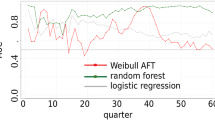Abstract
Obtaining an accurate model for predicting the probability of default is a critical requirement for financial institutions. Nowadays, COVID19 has produced high economic instability bringing borrowers’ delinquencies as well as moratorium regulations. During the KYC process for applicants, it is essential to estimate the probability of default for avoiding write-offs. However, there are several borrowers who, due to the pandemic, could have lost their jobs or decreased their income, producing several borrowers’ delinquencies, even write-offs by frequent delinquencies. Consequently, having a behavioral model for estimating the probability of default during the loan lifetime is vital for financial institutions. Hence, in this paper, we propose the first survival analysis-based approach for predicting the behavioral probability of default. We collected two real financial databases from different countries with different borrowers’ characteristics. From our experimental results, we can conclude that Logistic Hazard provides better results than Deep Hit for predicting the behavioral probability of default. Based on our experimentation and the risk analysis experts, Deep Hit provides inconsistent results for forecasts greater than six months while considering the financial changes due to the COVID19. Otherwise, Logistic Hazard is more accurate in forecasting the behavioral probability of default for a year, and it shows results more appropriate to risk analysis experts.
Access this chapter
Tax calculation will be finalised at checkout
Purchases are for personal use only
Similar content being viewed by others
Notes
References
Arya, S., Eckel, C., Wichman, C.: Anatomy of the credit score. J. Econ. Behav. Organ. 95, 175–185 (2013)
Gensheimer, M.F., Narasimhan, B.: A scalable discrete-time survival model for neural networks. PeerJ 7, e6257 (2019)
Gerds, T.A., Schumacher, M.: Consistent estimation of the expected brier score in general survival models with right-censored event times. Biom. J. 48(6), 1029–1040 (2006)
Kvamme, H., Borgan, Ø., Scheel, I.: Time-to-event prediction with neural networks and cox regression. J. Mach. Learn. Res. 20(129), 1–30 (2019)
Kvamme, H., Borgan, Ø.: Continuous and discrete-time survival prediction with neural networks. Lifetime Data Anal. 27(4), 710–736 (2021). https://doi.org/10.1007/s10985-021-09532-6
Lee, C., Zame, W.R., Yoon, J., van der Schaar, M.: Deephit: a deep learning approach to survival analysis with competing risks. In: Thirty-Second AAAI Conference on Artificial Intelligence, pp. 2314–2321 (2018)
Loyola-González, O.: Black-box vs. white-box: understanding their advantages and weaknesses from a practical point of view. IEEE Access 7, 154096–154113 (2019)
Merćep, A., Mrčela, L., Birov, M., Kostanjčar, Z.: Deep neural networks for behavioral credit rating. Entropy 23(1), 27 (2020)
Narain, B.: Survival analysis and the credit-granting decision. In: Thomas, L., Crook, J., Edelman, D. (eds.) Credit Scoring and Credit Control, pp. 109–122. Oxford University Press, Oxford (1992)
Rychnovsky, M.: Survival analysis as a tool for better probability of default prediction. Acta Oeconomica Pragensia 26(1), 34–46 (2018)
Tong, E.N., Mues, C., Thomas, L.C.: Mixture cure models in credit scoring: if and when borrowers default. Eur. J. Oper. Res. 218(1), 132–139 (2012)
Uno, H., Cai, T., Pencina, M.J., D’Agostino, R.B., Wei, L.J.: On the c-statistics for evaluating overall adequacy of risk prediction procedures with censored survival data. Stat. Med. 30(10), 1105–1117 (2011)
Wang, Z., Jiang, C., Ding, Y., Lyu, X., Liu, Y.: A novel behavioral scoring model for estimating probability of default over time in peer-to-peer lending. Electron. Commer. Res. Appl. 27, 74–82 (2018)
Yeh, I.C., hui Lien, C.: The comparisons of data mining techniques for the predictive accuracy of probability of default of credit card clients. Expert Syst. Appl. 36(2, Part 1), 2473–2480 (2009)
Author information
Authors and Affiliations
Corresponding author
Editor information
Editors and Affiliations
Rights and permissions
Copyright information
© 2022 The Author(s), under exclusive license to Springer Nature Switzerland AG
About this paper
Cite this paper
Suárez-Ramírez, C.D., Martínez, JC., Loyola-González, O. (2022). A Novel Survival Analysis-Based Approach for Predicting Behavioral Probability of Default. In: Vergara-Villegas, O.O., Cruz-Sánchez, V.G., Sossa-Azuela, J.H., Carrasco-Ochoa, J.A., Martínez-Trinidad, J.F., Olvera-López, J.A. (eds) Pattern Recognition. MCPR 2022. Lecture Notes in Computer Science, vol 13264. Springer, Cham. https://doi.org/10.1007/978-3-031-07750-0_6
Download citation
DOI: https://doi.org/10.1007/978-3-031-07750-0_6
Published:
Publisher Name: Springer, Cham
Print ISBN: 978-3-031-07749-4
Online ISBN: 978-3-031-07750-0
eBook Packages: Computer ScienceComputer Science (R0)





